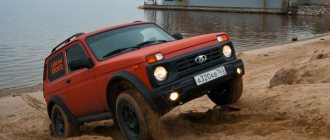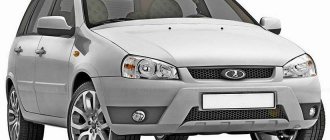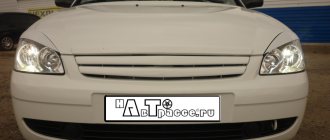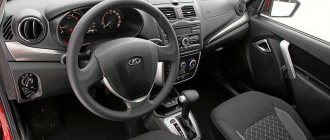Each automaker in history has its own unique and interesting examples. For Mercedes this is the 140th “boar”, for BMW it is the M5 sedan. The domestic IL was no exception. Yes, yes, this manufacturer also has something to brag about. Few people know, but in the 90s the IZH-2126 4x4 all-wheel drive vehicle was produced. The car was built on the basis of the regular Oda and modified in several places. IZH-2126 4×4 can now be purchased on the secondary market. Why is this model so famous and what features does it have? We will talk about this in our article today.
Appearance
The body of a conventional single-wheel drive 5-door hatchback IZH-2126 was taken as the basis. The reader can see what its all-wheel drive modification looks like in the photo below.
In general, the appearance of the car deserves attention. It is not necessary to perform tuning on the IZH-2126 4×4 hatchback. The body kit doesn't seem scary or dull. IZH-2126 4×4 is a kind of rally car created for ordinary citizens. Something similar was produced at AvtoVAZ at that time. This is the Lada Tarzan, created on the basis of an ordinary eight.
Dimensions, ground clearance
The body dimensions are almost identical to the Oda. Thus, the length of the all-wheel drive Izh is 4.07 meters, width 1.65 meters, height 1.45 meters. At the same time, the IZH-2126 060 4×4 was a very light car. Its curb weight is only 980 kilograms. In terms of ground clearance, the body has been raised 6 centimeters. But the suspension elements (including axles) remained at the same level. Therefore, the fair ground clearance was only 15.5 centimeters. But the lifting angles have increased significantly due to the high location of the bumpers. The machine copes well with loose snow and wet primers.
IZH-2126 "ODA"
Initially, the car was called “Orbita”, but the name “Orbita” was almost never indicated, since the “Orbit” trademark was already registered abroad (that was the name of the ItalDesign concept car). On the back door of the car until 2000 there was an original “IZH2126” nameplate, replaced by “ODA” and “1.6c” stickers (there were also 1.7 and 1.8, depending on the engine).
The instrument panel was borrowed from the 41st Moskvich, and the headlights and steering wheel were from the “eight” (since 2000, the steering wheel from the “ten” was installed) - unification of spare parts with other domestic cars simplified operation, but gave the “Izh” the appearance of a kind of “hodgepodge” ", which was not good for the image. In addition, the large, angular headlights of the VAZ-2108 mediocrely fit into the front end of the Izha, which was originally designed for low round headlights.
The clutch drive is hydraulic. The front suspension is MacPherson strut, the rear suspension is almost similar to the Zhiguli.
Large-scale "Oda" was produced with three types of engines - VAZ-2106 1.6l, UZAM-3317 1.7l and UZAM-3313 1.8l. Small-scale or experimental front- and all-wheel drive versions of the car with various engines were also produced (VAZ-21084, 2106, 21213, 2130, 21214, Hyundai G4GM of the Beta family, volume 1.8 liters, two-liter injection UZAM-248i). Small-scale modifications of cars were carried out by Izhevsk. Also, the plant produced an all-wheel drive version 2126-060 with a VAZ-21213 engine, put on the conveyor according to the technical documentation of Norma-Auto with minor design changes.
In 2003, the car received an original instrument panel.
In 2004, the instrument cluster was modernized and received one (two) liquid crystal displays. The upholstery was also updated - it became two-tone: gray bottom, black top. External restyling was being prepared, which, according to available information, was supposed to bring new bumpers to match the body color, sidewall moldings, and narrow headlights borrowed from VAZs of the “thirteenth” family.
On July 1, 2005, the entire Izh-2126 family was discontinued.
SAFETY
When developing the Izh-2126 Oda, it went through a full cycle of tests, including crash tests according to the standards that were in force at the time it was put into production, but it was not ready for the emergence of new standards for offset (R94) and lateral (R95) impacts. As a result of the crash test conducted by Autoreview (frontal impact according to EuroNCAP standards), the car received 2 points out of 16. The plant designers did a lot of work to change the design and strengthen the body, including using the test results of Autoreview, and achieved a positive result (tests were carried out at AvtoVAZ), but these changes did not go into series, due to the car being discontinued from production.
Specifications
The engine compartment of this car is quite large, so different engines were installed here. The initial one was the VAZ engine 2106 with a volume of 1570 cubic centimeters. This carburetor engine developed 76 horsepower and 120 Nm of torque. Among the advantages of this unit, reviews note low fuel consumption. Even with all-wheel drive, the IZH-2126 070 4×4 consumed no more than ten liters of gasoline in the city. On the highway this figure was seven liters. But consumption largely depended on speed. So, the most economical mode for Izha is 90 kilometers per hour. At 120 the car was already spending 11-12 liters per hundred. And the maximum speed of this engine was 130 kilometers per hour.
Chassis
Since the IZH-2126 4×4 hatchback is an all-wheel drive model, engineers had to make some changes to the suspension design. Thus, unified levers with a rear-wheel drive model were installed at the front. MacPherson struts came with a welded steering bipod. The steering knuckles were from a VAZ-2108. A spacer was installed between the stand and the fist. In this simple way, engineers achieved a significant increase in ground clearance.
The rear was also not without modifications. Special spacers are welded under the springs from the factory. The Panhard rod has also been improved. The shock absorbers have more travel. The final drive has a ratio of 4.22, which is higher than that of the single-wheel drive version. And the front gearbox on the IZH-2126 4x4 was installed from the Niva.
Of the original developments, it is worth noting the transfer case. It was created by the IZh designers themselves. This box provided permanent all-wheel drive with mechanical forced differential locking. This gave the car incredible off-road performance. The instructions for the IZH-2126-070 4×4 say that to turn on the transfer case you need to move the small lever away from you, which is located in the area of your right foot. The second lever is responsible for blocking.
History of creation [edit | edit code]
The all-wheel drive Izh appeared as a result of tuning the regular Oda. Back in 1995, Norma-Avto CJSC produced the first version of the Izh-2126-060 4x4 based on the 213 Niva units with independent rear suspension. The engine was installed on a subframe of our own production, welded from pipes (this is generally the original design of Norma, which later migrated to the factory Oda 4x4). The front arms were installed from the Niva with a transition piece for the VAZ-2108 ball joint. Steering knuckle - VAZ-2108.
Front-wheel drive is not a panacea
One way or another, the plant's designers began development anew and managed to discover an interesting thing - in the few years that have passed since the creation of Start, the automotive world has already overestimated all the advantages that front-wheel drive has. It turned out that lighter weight, economy and handling were not as great as thought. Most innovations had nothing to do with front-wheel drive at all. These are hatchback-type bodies, MacPherson strut suspension, and rack-and-pinion steering.
Recommended for production
Five years later, after minor modifications, the Izh-2126 was approved for production. At first, the model received the temporary name “Orbit”. But later it was renamed “Oda”.
The advantage of this machine was the great unification of components and assemblies with other main manufacturers of the USSR. Thus, the car was unified with the VAZ-2106, AZLK-2141, M-412 and other models. This approach allowed Izhmash to significantly save on development costs, as well as improve maintainability. The appearance of the Oda was greatly spoiled by the front optics from the VAZ-2108.
When production was established, it turned out that this rear-wheel drive car had many fans, and the assembly proceeded more steadily. Having created the basic version, the factory decided to implement all the capabilities of rear-wheel drive. This is how a pickup truck based on Oda was born - “Version”.
Crossover for pennies: test drive and off-road tuning Izh Oda
The hero of this story is IZH-2126 Oda, produced in 2002. One of our readers bought this car as an auxiliary vehicle for driving to the country, fishing and hunting. It is not very comfortable for everyday travel, so its owner drives around the city in another car. However, on active weekends, the “cross-hedgehog”, as their owners lovingly call IZH, is certainly kicked out of the stall.
Outside
Describing the appearance of the “hedgehog”, on the one hand, is pointless, but on the other hand, there are not so many of them left alive, and not every car enthusiast 20-25 years old, ask him about the “hedgehog”, will immediately remember what it is generally for the make and model.
The appearance of the 2126 is traditional for hatchbacks and, in principle, even relatively harmonious. Although a person who is no stranger to automotive design and history will easily notice in its outlines a certain “ersatzness” characteristic of Soviet cars, to which the Udmurt enterprise belonged. This car, like the Tavria, was insultingly called “the beggar’s nine” throughout its production and sales... Actually, the car’s headlights were actually borrowed from the VAZ “nine”, but all the other body elements are their own, from others “ our marks" are not suitable. The dynamic appearance characteristic of many hatchbacks is greatly spoiled by Oda’s ridiculous “sagging” rear wheel arches, reminiscent of a similar solution on the Daewoo Nexia.
Inside
The inside of the car is “waist-deep wooden.” Not IZH-2126 in general, of course, but this particular copy.
Like many cars of the Soviet and early Russian era, Oda was guilty of a terrible design of the interior plastic of the dashboard and trim. At the time of its appearance, domestic designers did not yet know how to design large plastic arrays, and the dashboard, along with the floor tunnel and everything else in the cabin, rattled, creaked and crunched like your orchestra. All connections of plastic elements suffered from fragility, curvature, and a tendency to self-deformation over time, and there was no talk at all about anti-squeak sealing of the joints.
There was no desire to bring the initially poor design to fruition, so the owner simply removed the entire Izh dashboard, floor tunnels, door trim, rear arch trim from the trunk and other decorative plastic and took it to the trash in a couple of visits. Instead, a new “dashboard” was made from plywood, then covered with “cheerful fabric” - in the sense of a light-colored carpet. The same was done with the doors.
The ease and ease in handling the car hints that its owner was clearly close to the philosophy of not giving a fuck of the famous St. Petersburg art community Mitkov, adhering to which, he simply approached the car with a hatchet and, spitting out the cigarette, cut off everything unnecessary. As a result, thanks to the style of a kind of military minimalism, we managed to achieve the main thing - to get rid of the endless “noise concert” in the cabin.
1 / 3
2 / 3
3 / 3
Serious “collective farming” also covers the back row of seats. In fact, both the seat itself and its back were also removed and thrown away. Instead, a flat plywood floor appeared - flush with the trunk floor. The car became actually a two-seater. The purpose of this compromise alteration was to create a full-fledged sleeping rookery, necessary for hunting and fishing trips.
1 / 2
2 / 2
So that a person of above average height could sleep in the car, fully stretched out, we had to make an additional removable “table” with removable legs. After moving the front passenger seat all the way forward, the “table” was placed in place of the rear passenger’s legs. As a result, the resulting sleeping place allowed me to lie on a flat surface, comfortably stretching out to my full height.
1 / 2
2 / 2
"Cross hatchback"
Buying a rear-wheel drive Oda for nominal money, its current owner purposefully looked for a tattered and shabby copy, which he would not mind tearing and scratching against bushes and trees in the future. But at the same time, the car had to have impeccably strong sills and bottom, so as not to have to deal with expensive and completely pointless tin painting work on such a cheap car. Actually, such a copy was found for 30,000 rubles. To transform the “hedgehog” into a “cross-hatchback”, three simple measures were planned.
Clearance
340 mm
The first is the installation of a self-locking differential in the rear axle, which allows the wheels of the rear axle to connect together when slipping and row powerfully through the mud. Despite the fact that many manufacturers make self-blocks for the VAZ “classic”, they are not suitable for Oda - the bridge of the “hedgehog”, although similar to the VAZ one, has its own original design. In other words, ready-made serial self-blocks for Oda did not exist in nature until the owner of the hero of this story became concerned about the issue. He began correspondence with all Russian manufacturers of self-locking differentials, and one of them unexpectedly agreed to develop a modification for IZH-2126! For this, however, a sample was required. On the website of free advertisements, the Odovsky bridge in Chelyabinsk, where the developer was located, was urgently found, the money was transferred to the seller of the bridge, after which representatives of the self-block manufacturing company came and took it away. As a result, after a few months, the initiator of this idea received the first free copy of a factory limited-slip differential for the IZH-2126, and even a purchased bridge, which was used as a sample.
The second event is a body lift. At the front, under the pillars there were homemade polypropylene spacers 45 mm thick, at the rear - rubber spacers 50 mm, reinforced springs from the VAZ-2104 and extended shock absorbers. The lift, of course, is nonsense according to truly off-road standards, and no matter how you lift it, the ground clearance is limited by the low-hanging gearbox of the rear axle... But still, after lifting, the clearance under the sills of the raised car became equal to 340 millimeters, which is quite good in the “cross-hatchback” format .
The elevator can also be attributed to the small “cutting” that the “hedgehog” underwent - the lower “lip” about 4-5 centimeters high was sawed off from the front bumper with a grinder, reducing the approach angle.
Third, the tires are meaner and taller. The extra-budget solution was the installation of toothy AI-168U tube tires on the original 13-inch stamped wheels.
This rubber, I must say, is unique... Both in a good and a bad sense. First of all, it is unique in that it was developed in the USSR in the 60s, but for some reason it is still produced to this day, although it is hard to believe. The Altai Tire Factory is “cursed” for its production, probably as God’s punishment to atone for some of its old sins before the Almighty.
AI-168U - tires with a very high profile. With them, even on the original 13-wheel drives, the wheels are so high that the rear is only a centimeter short of reaching the front edges of the arches! Well, the main thing is that this is actually the only 13-diameter rubber that can honestly be classified as an AT class - “all terrain”.
“AIshka” makes a terrible noise and howls on the asphalt, it doesn’t hold the road well, but in the mud these old-school tires work really well!
Iron
Izh-2126 is a machine that was initially not very cleverly designed and has a lot of inherent problems. The first thing the owner did was replace the “branded” buggy Omsk five-speed gearbox with a trouble-free, Kalashnikov-like, four-speed gearbox from a VAZ “classic”. In the engineering community, Omkis are famous for their massive tendency to sudden failure due to bursting and falling apart gear hubs, despite the fact that there are no spare parts for them at all. It wasn’t worth the risk of waiting for the box to jam several hundred kilometers from home.
Articles / History Overboard and out of time: why Izhevsk Oda never entered the orbit of success Having successfully mastered the rear-wheel drive liftback Izh-combi, which we recently talked about, Izhmash designers started thinking about more progressive designs. It quickly gained popularity in the world then... 45635 13 20 09.11.2016
To install the VAZ gearbox, I had to trim the driveshaft shank a couple of centimeters and redo the rear cross member and the gearbox cushion - these are standard procedures when changing the gearbox on Oda. Then the owner shook up the entire suspension and the entire braking system, converting it from diagonal to front/rear and replacing the sluggish Moskvich master cylinder, vacuum brake and rear wheel cylinders with VAZ ones. The steering rack was removed and rebuilt.
And then... then the owner of the car turned up for a ridiculous amount of money with an injection engine from a Lada Four, which was installed instead of the standard carburetor “bolt-on” assembly. True, the “bolt-on” only concerned the motor - we had to tinker with its periphery. Since the Itelm control unit, which came with the engine, required two lambda probes for operation, which were not cheap, and there was no desire to weld fasteners for them into the “carburetor” muffler, I had to turn to the “shamans”. In exchange for a standard ECU, with a small surcharge, we received a rebuilt “January” ECU with optimized firmware for the classic “vasomotor”, which does not require lambdas, a knock sensor, or an adsorber. The fuel pump was taken from Volgov, external type.
Actually, as part of the owner’s hobby love for tinkering with hardware with his own hands, almost everything in the car was rebuilt. She spent a lot of energy and money... And here the question reasonably arises - in fact, what is the cost of such a decision? Wouldn't it be cheaper to buy an old but lively Niva or UAZ?
The question is correct, but the answer is simple! For 30,000 rubles spent on the purchase of the car itself, the same Niva can only be bought at a ferrous metal collection point and in the form of that very ferrous metal. And the transformation of a stock Oda into a “cross-hatchback” included only a lift (free), a self-block (free + 3,000 rubles for the services of a transport company), and new wheels (5,500 rubles). All the other above-mentioned repair and maintenance work was done by the owner solely out of love for perfectionism and had no direct connection with the transformation of the car into a “cross-hatchback”. In principle, the car, even without all this fuss, was initially quite on the move... But this is not our method, Shurik! (With)
In move
As one would expect, the highly raised body of the cross-hatchback, whose chassis even in the stock version was very far from examples of driver refinement, led to an even more significant decrease in stability and controllability. The maximum comfortable speed of the Cross-Oda in a straight line is 80-85 km/h. However, this was obvious and predictable - everything was started for the sake of advantages, of which there are also many.
Maximum comfortable speed
80-85 km/h
Speed bumps go by without braking at all, and the vibration combs that warn the wheels about an approaching pedestrian crossing are completely inaudible in the cabin, despite the absence of any hint of sound insulation.
Well, and, in fact, the main thing is off-road driving, where the car demonstrates exactly what they wanted from it! The self-locking differential quickly picks up both wheels on the rear axle when moving forward, and when moving backward - instantly, giving a short slip even when leaving the garage in reverse. The main limiter is the axle gearbox, which, in general, is quite easy to place on a hillock, after which the self-blocking abilities are useless. For this reason, the driving style of a cross-hatchback is not similar to the driving style of a full-fledged SUV. You have to jump through difficult areas straight away and under tension, like on any city “puzoter”. However, the lift, toothy tires and self-blocking still allow you to move and not get stuck.
Yes, the “cross-hatchback” does not show the results of either a UAZ or even a Niva on good tires, but, nevertheless, it surpasses in cross-country ability almost any city all-wheel drive crossover, of which the owner of this “Hedgehog” has already had to go around, get stuck, and even help pull out.
Model history
The IZH-2126 hatchback was produced at the Udmurt plant from 1990 to 2005 inclusive. Until 2000, the model was called Orbita and was produced in negligibly small quantities due to financial and organizational troubles at the enterprise. Substantial serial production actually began only in 2000, after the change of owner to IZH-Auto and the relaunch of the model under the name Oda.
Izh-2126 '1990–99
The car had rear-wheel drive or all-wheel drive, a five-speed manual transmission, 1.7-2.0-liter UZAM engines and a 1.6-liter VAZ-2106. In recent years, Oda has been equipped with injection versions of engines and “digital” dashboards from the VAZ-2110.
In the station wagon, Oda was very ugly and was called Fabula; There were also rare versions of the "Hunter" in a pickup truck.
1 / 2
2 / 2
Only a few thousand all-wheel drive variations of Oda and Fabula were produced - they were made both by the plant itself (in a simplified version) and by the Udmurt one. The 4x4 versions, distinguished by a proprietary plastic body kit, were equipped with a transfer case built into the gearbox, and instead of manually locking the center differential, they had a limited-slip differential of the “quif” type.
Izh-2126-060 Oda 4×4 '2002–05
It should be noted that in the early 2000s, Oda became famous for a large-scale advertising campaign with the participation of the well-known TV presenter Leonid Yakubovich on TV, in the press and on various kinds of posters and banners. The key advantage of the car was the galvanized body, which many people bought into. In fact, galvanization was very ambiguous, because the advertising did not specify its volume. And on the first machines it was very small, growing gradually and slowly. As a result, the Odas of 2002-2004 resisted corrosion quite well, but the earlier ones rotted miserably, like the VAZ “classic”.
Izh-2126 Oda '2002–2005
Survey
What is your attitude to such tuning?
Your voice
Total votes:
"Oda": four-wheel drive and other modifications
And finally, we further produced the Izh “Oda” 4x4 car - this is a crossover, which is a descendant of the “Muscovites” and “Pobed” with all-wheel drive.
The transmission system was installed from Niva. In this version, the sound insulation of the cabin has been significantly improved. Several more cars were subsequently created on the basis of the Oda. Thus, the latest mass-produced car is the Izh “Oda Fabula” 4x4 station wagon with rear-wheel drive and all-wheel drive. A luxury version of the popular Nika hatchback was also produced.
Specifications
Izh "Oda" 4x4 was manufactured in a hatchback body. The length of the body was 4068 mm, the width was 1650 mm. The height of the car reached 1450 mm. The ground clearance for a crossover is small - only 15.5 centimeters. Wheelbase – 2470 mm.
As for the engines, there were several of them. Thus, a VAZ-2106 engine with a volume of 1.6 liters and a power of 80 hp was used. With. Along with it, UZAM-331 with a volume of 1.7 liters and a power of 85 hp was installed. With. There was another AvtoVAZ unit - VAZ-2130. Volume 1.8 liters and power 79 liters. With. This unit was equipped with the Izh “Oda Fabula” 4x4 car. No injector was used here - only a carburetor. The two-liter UZAM-3320 engine had a power of 115 hp. With.
Product N104 IZH-Okhotnik 4x4 – “Rescuer of Lake Valdai”
Izh-2717 “Oda-version” is a Russian light truck with van and pickup bodies. It was produced in 1997-2005 at the Izhevsk Automobile Plant and was positioned as a model designed to replace the morally and technically outdated “heel” 2715. Controllability, visibility, stability and load capacity in this model are already an order of magnitude better.
Created on the basis of the Izh-2126 passenger model and featuring a modified suspension, specially adapted for cargo transportation: ground clearance increased to 230 mm; rear suspension - spring, instead of the lever-spring type installed on the passenger model taken as a basis; tires with increased load-carrying capacity, which made it possible to increase the payload to 650 kg. Using two pneumatic stops, the rear door is easily fixed in the upper (open) position. The front suspension is independent, spark plug type (McPherson). Izh-2717 was equipped with several types of engines. The most common engines are UZAM-3317, with a working volume of 1700 cc, with a power of 85 hp, and VAZ-2106, with a working volume of 1600 cc, with a power of 74.5 hp.
The prototype IZH-2126 appeared in 1984. On September 14, 1990, the body of the first IZH-2126 car was welded - a five-door hatchback with traditional rear-wheel drive and a VAZ-2106 engine. It was named "Orbit", and only in 1999 - the modern official name "Ode". Since the Orbit trademark has already been registered abroad.
A team of highly qualified specialists - constructors, designers, technologists and testers - worked to fine-tune the car to the required standards. According to the results of field tests at the test site in 1984, the IZH-2126 was not inferior to foreign cars in any respect. IZH-2126 meets the requirements for modern cars in terms of stability, controllability, and smoothness. Among the positive qualities of the Oda car is a spacious, comfortable interior and good aerodynamics, thanks to which the rear window of the car always remains clean, regardless of weather conditions. The owners also note the well-thought-out heating and ventilation system in the cabin.
The advantage of this machine was the great unification of components and assemblies with other main manufacturers of the USSR. Thus, the car was unified with the VAZ-2106, AZLK-2141, M-412 and other models. This approach allowed Izhmash to significantly save on development costs, as well as improve maintainability.
The following tells us what kind of cars they were. The all-wheel drive “Oda” took part in the “Eurasian Way” motor rally, which took the car far to the North, beyond the Arctic Circle. “Izhevsk” didn’t mind 40-degree frosts, long distances and hiking through the snowy desert. As for the usual “Oda” and “Fabula”, the first of them traveled from Moscow to Vladivostok, and the second - back, both without serious breakdowns.
Izh-2717, in turn, served as the basis for the creation of modification 27171 - a pickup truck and a version of an all-wheel drive pickup truck with an extended cab, including a place for transporting a dog.
Izh 21171 4x4 has an unofficial name - “HUNTER”. Indeed, it is difficult to imagine a more suitable car for outdoor activities, hunters, fishermen, and mushroom pickers. This car is universal - it moves equally easily both on asphalt roads and completely off-road. Increased cross-country ability is achieved through an all-wheel drive system with forced differential locking, an extended wheelbase, and high ground clearance of 190 mm. In addition to all-wheel drive with forced differential locking, the car has an extended wheelbase, high ground clearance, and wide tires with a diameter of 15 inches. The spacious body and reinforced rear suspension allow the vehicle to be loaded with 700 kg of cargo, and the folding sides make this process convenient and easy. With excellent power and dynamic performance, fuel consumption is low - only 9.7 liters per 100 km in the urban driving cycle.
Counting on the operation of the pickup truck in any conditions, they thought about making the cabin spacious and warm. A voluminous glove compartment, an open shelf for small items, and a small niche for papers. Another box for small items is hidden in the armrest between the seats. Everything is quite reasonable, accessible, although perhaps somewhat modest. The “long” cabin has two additional side windows, which, by the way, fit well into the appearance of the car, a small bench behind the front seats and a raised roof, borrowed from the Fabula station wagon. The cabin turned out to be interesting and very spacious.
A small batch of only 22 cars of this type was produced. It was this rare modification that was found in Naberezhnye Chelny and served as the basis for the Smirnov Design Bureau “Rescuer” project, when, according to the customer’s technical specifications, it was necessary to prepare a rare domestic car of a unique modification to participate in events held by the “All-Russian Water Rescue Society” in Valdai .
Water has always played a huge role in human life. The life, work, and leisure of many millions of people from generation to generation have been inextricably linked with water. The development of water spaces by humans has never been without sacrifices. Tragedies and accidents on the water brought to life the need to provide assistance to those in distress and, as a result, led to the emergence and development of the rescue business.
Famous Russian naval commanders F.F. Ushakov, D.N. Senyavin, M.P. Lazarev, P.S. Nakhimov, V.A. Kornilov and others believed that one of the important qualities of a sailor is his readiness and ability to provide assistance to those in distress on the water. On occasion, they themselves showed examples of courage in rescuing drowning people.
The idea of creating rescue stations using donations from private individuals arose in Russia from Kronstadt sailors. OSVOD, like most public organizations in Russia, experienced an extremely difficult time in the country's transition to a market economy.
The OSVOD councils and organizations failed to restructure themselves in a timely manner in the new conditions and to counter the negative phenomena that arose in the country in relation to voluntary public associations with new forms and methods of work. Councils and organizations of the Society, financed from the federal and local budgets, found themselves practically without funds. As a result, the number of members of the Society decreased significantly.
The redistribution of property that began sharply reduced the material base of the Society and deprived it of numerous rescue bases and training centers. Things got to the point that the Central Council of OSVOD lost its premises - an old mansion in the center of Moscow.
In 2003 A new stage has begun in the work of VOSVOD. By the decree of Russian President Vladimir Vladimirovich Putin “On improving the unified state system for preventing and eliminating emergency situations,” the Ministry of Emergency Situations was assigned the main responsibility among government bodies “for organizing the search and rescue of people in inland waters and the territorial sea of the Russian Federation.” The oldest public organization in the country, VOSVOD, which has been helping people for more than 130 years, could not stand aside.
In the document developed by the Ministry of Emergency Situations on the implementation of the Decree of the Head of State, regional divisions of the ministry are instructed to improve the mechanisms of interaction with local structures of the All-Russian Water Rescue Society. First of all, attention is drawn to the need to “organize work on interaction and coordination of VOSVOD activities to ensure the safety of people on water bodies.” In April 2004, Russia was visited by a delegation of the International Rescue Society of the United Europe, whose membership was lost by VOSVOD in the 90s of the last century. As a result of negotiations between the Chairman of the Central Council of VOSVOD, Petr Nelezin, and the President of the MOS, Klaus Wilkins, an agreement was reached that Russia would once again become a full member of the MOS.
According to the customer’s technical specifications, the vehicle had to be marked with the “VOSVOD” symbols and a certain list of rescue equipment and accessories. In particular, the car had to be equipped with a rescue board (AlTan Ministry of Emergency Situations).
The AlTan rescue board is designed for rescue work on water, on ice, and on snow. Light weight, the lower surface of the board in the form of a sled, and metal handles ensure the maneuverability of the rescue board on ice and water, as well as its easy transportation from the car to the shore of the reservoir.
- load capacity 150 kg;
- weight 35 kg;
- length 3.5 m;
- width 0.7 m;
- height 0.22 m;
- displacement 300 cubic meters;
- Capacity (simultaneous) of victims 1 person supporting 2 people.
The AlTan rescue board kit includes:
- paddle 1 piece;
- hook adjustable in length 1 piece;
- 2 metal handles for movement control;
- 2 metal handles in the front and several straps in the center for holding on the board;
To accommodate the board, as well as the rest of the rescue equipment and the application of VOSVOD paraphernalia, the pickup truck has undergone significant modification.
The SUV has changed its color by completely repainting both the internal and external parts of the body and elements of the decorative body kit in dazzling white and spectacular red. Design layouts were prepared for applying VOSVOD symbols and identification marks and inscriptions. Also, a trunk frame was integrated into the car, which is designed to attach a rescue board. Additional light has been installed for work at night. The show car was placed on rubber tracks, which, in addition to the additional demonstration effect, gave it exceptional off-road properties and increased ground clearance.
This example, after a series of finishing works, appeared in the updated appearance of the Valdai Lake rescue vehicle and currently exists in a single copy.
Specifications:
- Length, mm – 4370;
- Width, mm – 1630;
- Height, mm – 1690;
- Weight, kg – 1110;
- Maximum speed, km/h – 140;
- Load capacity, kg – 700;
- Engine – petrol;
- Engine capacity, cm3 – 1800;
- Power, hp – 92;
- Number of cylinders – 4;
- Ground clearance, mm – 220;
- Years of production – 2003;
- Year of manufacture – 2003;
- Circulation, copies – 22.
In the snow, on ice and in mud
This is the natural element for the domestic crossover. But as long as there is smooth and dry asphalt under the wheels, the car will not show any special abilities. The engines do not indulge owners with quick acceleration, the cabin is quite noisy, and the stiff suspension is also not very pleasing. Many people do not like the pedal assembly of the Izh “Oda” 4x4. But as soon as it starts snowing, the car turns into a leader on the road. While the surrounding cars travel at speeds of up to 40 km/h, Oda travels at the same high speed.
As long as the road is dry, the car will not be first in traffic light races. If you evaluate the fuel consumption of the IZH “Oda” 4x4 car and its technical characteristics, then you can forget about dynamic driving. But you just have to go beyond the asphalt, and the car’s potential will be fully revealed. Izh will pass where many ordinary cars begin to slip. Owners of all-wheel drive Oda are not worried about cross-country ability. Reviews say that the rigid suspension copes well with bumps, holes, and tram tracks. You don’t even have to carry a shovel with you – it’s not needed with all-wheel drive. It is almost impossible to park a car in urban conditions.
These are serious advantages for the Izh “Oda” 4x4 car. Reviews from the owners fully confirm this. The only negative, according to the owners, is high fuel consumption, especially in winter. But you can live with this - only expensive all-wheel drive jeeps have such capabilities. This is not available to everyone.
While producing the all-wheel drive Oda, Izhmash experimented tirelessly. Today there is a large and unknown number of configuration options. We came across a car with a fully independent suspension, a 1.8-liter VAZ-2130 engine, headlights from the “six” and 13-inch wheels. The diameter of the latter may be an inch larger, but in any case the Ode 4x4 looks quite low. Powerful, but completely non-functional running boards, enlarged wheel arches with plastic edging and kangurin slightly enliven the design that was developed twenty years ago for the rear-wheel drive model.
With the breeze on the asphalt.
Design
The renderings developed by the designer show a modern crossover, designed in a style that is typical for many budget SUVs (mostly Chinese). It, like, for example, Chery Tiggo 2, is distinguished by somewhat square outlines and slightly smoothed corners. At the same time, the Russian new product has a number of features that are unique to it.
Thus, the crossover IZH "Oda" 2021-2022 has a slightly rounded roof: it gradually rises up, coming from the heavily littered A-pillars, and in the center begins to move down, stopping at a small wing. The Russian new product is distinguished by an elongated front part of the body and a shortened rear part. The hood, which runs almost parallel to the road surface, is complemented by barely noticeable recesses on the sides. A similar feature is typical for the Mercedes-Benz GLB.
At the front of the new product there are large headlights. Moreover, the head optics have a unique architecture for budget crossovers. The role of the main headlight is performed by a large lamp placed in a special recess. Curving LED strips stretch above and below it, one of which is most likely in the form of DRLs, and the second is a turn signal. Between them and next to the radiator grille in the area where the headlights narrow, the developer placed 3 LED lights.
Decorative strips extend from the head optics and cross the plastic trim. The latter is probably responsible for the imitation of the radiator grille, since the crossover lacks it. Another interesting detail characteristic of the presented Oda crossover is related to the design features of the front bumper. In its center there is a large air intake with a fine mesh and clearly defined edges, slightly protruding above the body. Below, the developer placed another ventilation hole, separated from the top one by a plastic strip and complemented by a black body kit. This combination of design solutions seems to have been borrowed from the latest Toyota RAV4.
However, it cannot be said that the Russian model was copied from the Japanese one. In particular, the opposite is evidenced by the presence of huge side holes for ventilation of the brake mechanisms. Following the example of many modern crossovers, the new Oda is complemented by a wide plastic body kit that runs along fairly large wheel arches and the bottom of the side doors. The 2021-2022 IZH “Oda” crossover is distinguished by its relatively high ground clearance, the size of which may reach 190 mm. This decision is due to the fact that the car is initially aimed at the Russian market, whose consumers often pay attention to cars with high ground clearance.
The stern of the new Oda has a stepped shape. Moreover, the transitions between individual parts have a clear outline. The new product received large rear optics, connected by an equally wide central brake light. Immediately below it is a rectangular protrusion, which probably serves a decorative function. Also at the stern, the developer placed a large bumper with additional brake lights and four exhaust pipes. Most likely, 3 of them are imitation and are designed to diversify the appearance of the crossover.











